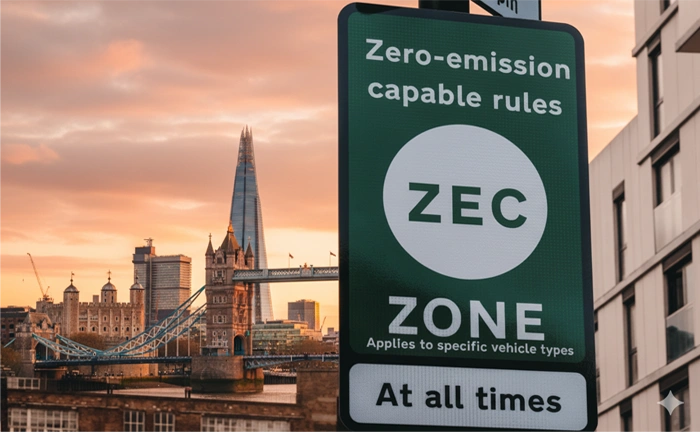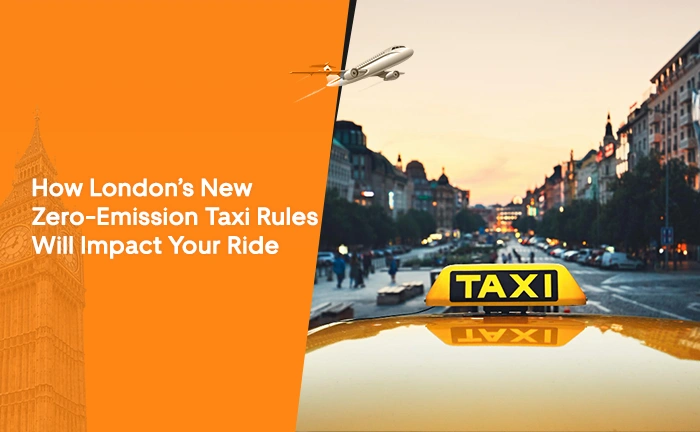The transport sector contributes considerably to global emissions and air contamination. In our efforts to achieve a cleaner and more sustainable future, the shift to electric vehicles (EVs) offers a convincing solution. Electric London Taxi Service, in particular, has significant potential to enhance air quality and cut emissions in urban settings.
This blog examines the advantages and difficulties of shifting taxi and ride-sharing fleets to electric vehicles, emphasizing their effects on air quality and emissions.
What are the Zero-Emission Capable Rules?
New regulations introduced in London require that taxis and private hire vehicles adhere to zero-emission capable (ZEC) standards under specific licensing conditions. These regulations are included in the city’s efforts to achieve cleaner air and reach its net-zero goals.

Due to increasing worries regarding climate change and air pollution, new regulations have been implemented that mandate taxis and private hire vehicles to be zero-emission capable (ZEC). This initiative is incorporated into the city’s larger plan to reach net-zero carbon emissions, reduce pollution from traffic, and enhance urban living conditions.
For passengers, this alteration will yield advantages as well as necessitate adjustments. Cleaner air, quieter journeys, and access to more eco-friendly travel options are evident benefits. However, it is important to take into account practical ramifications as well, such as possible alterations to fares, availability issues, and complications regarding charging.
Grasping the impact of these regulations on your journey can aid you in making knowledgeable decisions when booking a London airport transfer in the future.
How London’s New Zero-Emission Taxi Rules Will Impact Your Ride
-
Cleaner and Healthier Journey
One of the greatest benefits of zero-emission-capable taxis is the instant enhancement of air quality. ZEC vehicles, powered by electricity or cleaner hybrid technology, significantly reduce pollution levels compared to older diesel taxis that emit nitrogen oxides and harmful particulates. This implies that passengers can enjoy cleaner air on their trips and a reduced risk of coming into contact with exhaust fumes, both within the vehicle and in its vicinity. In bustling urban areas such as central London, where traffic jams frequently keep pollution at ground level, this cleaner mode of transport plays a direct role in improving health by lowering the chances of respiratory problems and making commutes significantly fresher and more enjoyable.
-
Access to Low-Emission Zones without Extra Costs
To address pollution, London has implemented initiatives such as the Ultra Low Emission Zone (ULEZ) and the Congestion Charge Zone. Taxis that do not comply with emissions standards may incur extra charges when entering these zones, and these expenses can occasionally be transferred to passengers. ZEC taxis, on the other hand, are built to meet these regulations, allowing them to move freely in these areas without additional charges. This means that passengers can enjoy smoother journeys throughout the city, especially in central London, without concerns about hidden fees or route limitations. Additionally, it guarantees pricing that is more dependable and not influenced by environmental surcharges.
-
Supporting Sustainable Travel Choices
When passengers opt for a ZEC taxi, they make a direct contribution to the climate and air quality objectives of London. Each trip in a vehicle that can operate without emissions contributes to the reduction of the city’s carbon footprint and aids in the overall shift toward environmentally friendly transportation. This provides an additional source of gratification for eco-aware travellers: their travel decisions are not just convenient, but also sustainable. Backing these taxis also promotes a quicker embrace of clean technology in the industry. This joint endeavor contributes to the development of a healthier, more sustainable city over time, so that passengers can enjoy the dual advantage of a dependable ride today and a cleaner London in the future.
Advancement of Sustainable Transportation
A key contributor to global carbon emissions is the transportation sector. This has led to an urgent need for mobility solutions that are more sustainable. A promising option is to electrify the taxi and ride-hailing sectors. Taxis are an ideal candidate for electrification due to their high utilization rates and substantial contributions to urban emissions.
Electric taxis and ride-sharing services provide a variety of advantages, such as enhanced air quality, decreased noise levels, and possible financial savings. Nonetheless, they encounter major difficulties, mainly concerning infrastructure, vehicle expenses, and battery technology. Also, you can use taxi fare calculator to estimate your fare with electric vehicles.
Final Words
Switching to electric taxis and ride-sharing services is a major move towards sustainable mobility and cleaner cityscapes. We can develop transportation systems that are healthier and more sustainable by taking advantage of the advantages offered by electric vehicles, including enhanced air quality and diminished emissions. Through supportive policies, collaboration, and technological advancements, we can overcome challenges to successfully adopt electric taxis and ride-sharing services, contributing to a greener and more sustainable future.

